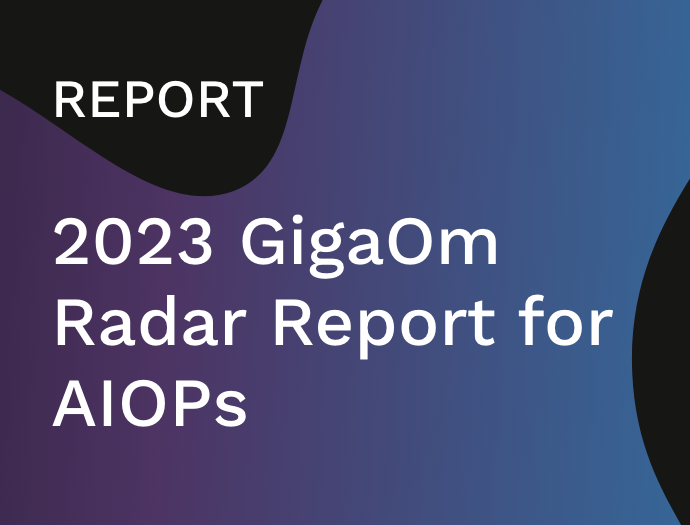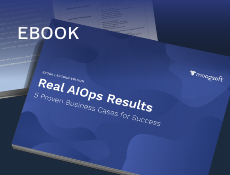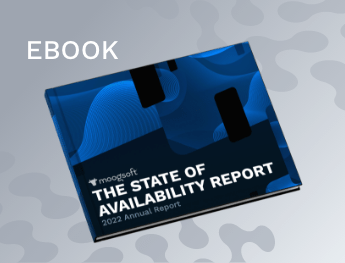An Everything Guide to AIOps
What is AIOps?
Artificial intelligence for IT Operations (AIOps) is the application of AI, and related technologies, such as machine learning and natural language processing (NLP) to traditional IT Ops activities and tasks.
Through algorithmic analysis of IT data and Observability telemetry, AIOps helps IT Ops, DevOps, and SRE teams work smarter and faster, so they can detect digital-service issues earlier and resolve them quickly, before business operations and customers are impacted.
With AIOps, Ops teams are able to tame the immense complexity and quantity of data generated by their modern IT environments, and thus prevent outages, maintain uptime and attain continuous service assurance.
With IT at the heart of digital transformation efforts, AIOps lets organizations operate at the speed that modern business requires, and deliver a stellar user experience.
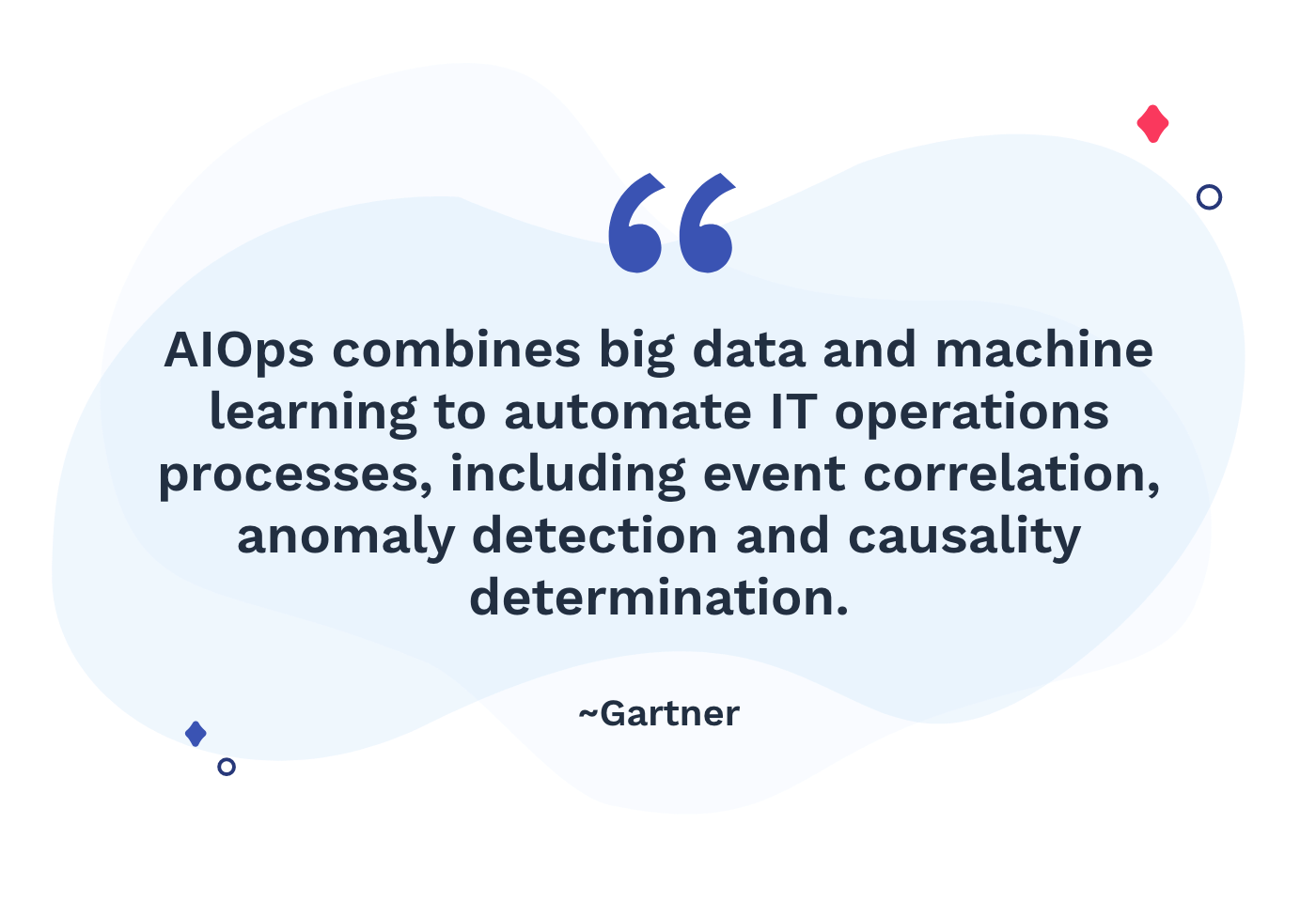
How can AIOps help you?
Through algorithmic analysis of IT data and Observability telemetry, AIOps helps IT Ops, DevOps, and SRE teams work smarter and faster, so they can detect digital-service issues earlier and resolve them quickly, before business operations and customers are impacted.
With AIOps, Ops teams are able to tame the immense complexity and quantity of data generated by their modern IT environments, and thus prevent outages, maintain uptime and attain continuous service assurance.
With IT at the heart of digital transformation efforts, AIOps lets organizations operate at the speed that modern business requires, and deliver a stellar user experience.
An AI Platform for Today - and the Future
-
Systems: At the core is the complexity of systems that are modular, distributed, and dynamic, and whose components are ephemeral.
-
Data: The second layer is the data these systems generate about their internal operations — logs, metrics, traces, event records, and more. This data is complex because of its high volume, specificity, variety, and redundancy.
-
Tools: The third outer layer is the complexity of the tools used to monitor and manage the data, and the systems. There are more and more tools, with increasingly narrow functionality, that don’t always interoperate and thus create operational and data silos.
As IT infrastructures evolve, old rules-based systems fall short because they rely on a predetermined, static representation of a mostly homogeneous, self-contained IT environment.AIOps uses machine learning and data science to give IT operations teams a real-time understanding of any issues — including new, unforeseen problems for which rules haven’t been crafted yet — that affect the availability and performance of digital services.
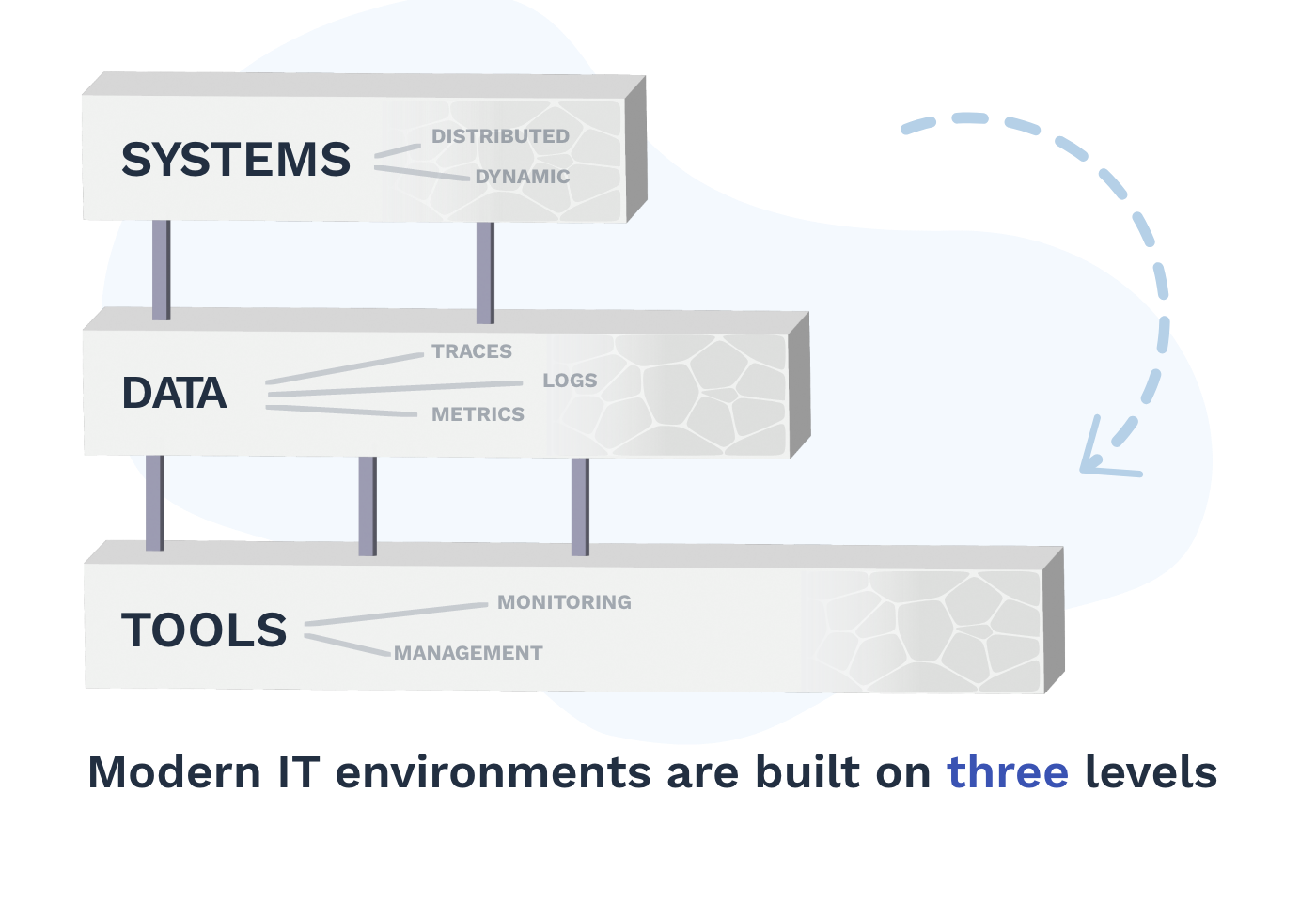
How Does AIOps Work?
Not all AIOps tools are created equal. To get the most value, it is recommended that an organization deploy it as an independent platform (domain-agnostic) that ingests data from all IT monitoring sources, and acts as a central system of engagement.
Such a platform must be powered by five types of algorithms that fully automate and streamline five key dimensions of IT operations monitoring.
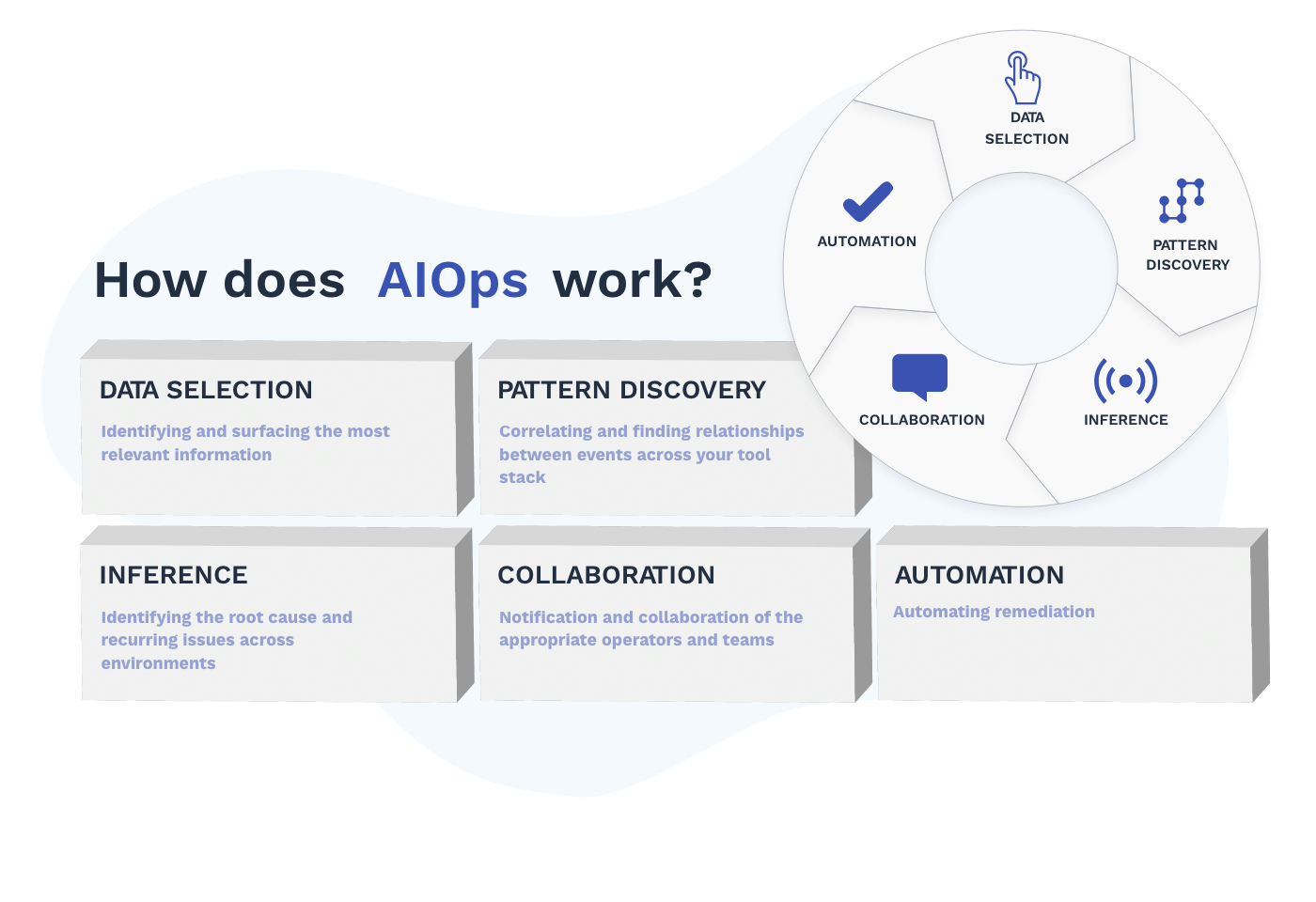
-
Data Selection: Taking the massive amount of highly redundant and noisy IT data generated by a modern IT environment and selecting the data elements that indicate there’s a problem, which often means filtering out up to 99% of this data.
-
Pattern Discovery: Using correlation to find relationships between the selected, meaningful data elements, and grouping them, for further advanced analytics.
-
Inference: Also called root cause analysis, identifying root causes of problems and recurring issues, so that you can take action on what has been discovered.
-
Collaboration: Notifying appropriate operators and teams, and facilitating collaboration among them, in particular when individuals are geographically dispersed, as well as preserving data on incidents that can accelerate future diagnosis of similar problems.
-
Automation: Automating response and remediation as much as possible, to make solutions more precise and quick.
AIOps is the Nucleus of Digital Operations
In a real-world setting, the AIOps platform ingests heterogeneous data from many different sources about all components of the IT environment — networks, applications, infrastructure, cloud instances, storage, and more.
- Using algorithms, AIOps solutions remove noise and duplication, and selects only the truly relevant data. This algorithmic filtering massively reduces the number of alerts Ops teams must deal with, and eliminates duplication of work caused by redundant tickets routed to different teams.
- It then groups and correlates this relevant information using various criteria, like text, time, and topology. Next, it discovers patterns in the data and infers which data items signify causes, and which signify events.
- The platform communicates the result of that analysis to a virtual collaborative environment where everyone involved in solving an incident has access to all the relevant data. These virtual teams can be assembled on the fly, enabling different specialists to “swarm” around an issue that spans technological or organizational boundaries.
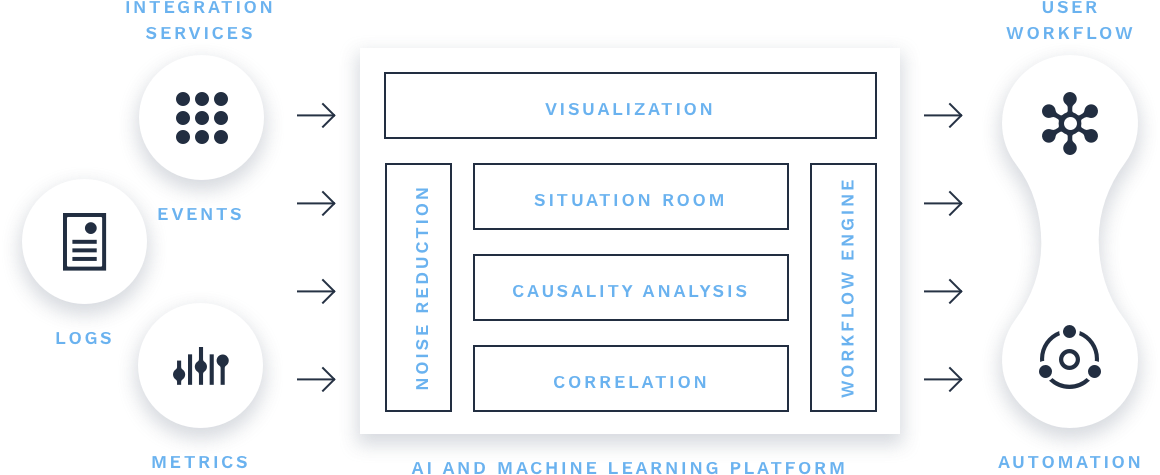
What You Need to Know About AI & Machine Learning
The AI in AIOps is not general intelligence. Instead, a set of specialized algorithms are narrowly focused on specific tasks. Different algorithms can pick out significant alerts from a noisy event stream, identify correlations between alerts from different sources, assemble the correct team of human specialists to diagnose and resolve a situation, propose probable root causes and possible solutions based on past experiences, and learn from feedback in order to improve continuously over time.
Clustering and correlation is the most complex and crucial step, requiring multiple different approaches. A combination of historical pattern-matching and real-time identification helps IT Ops teams to identify both recurring and net-new issues. Raw monitoring events may be enriched by reference to an external data source, where available; this enrichment helps to deliver better predictive correlation, as well as service impact information.
How Can AI Help Human Operators?
AIOps combines the automation of tactical activities with strategic oversight by expert users, instead of wasting the time and expertise of skilled DevOps, SRE, and IT Ops pros on “keeping the lights on”. Simply put, it’s humanly impossible to manage the volume of data being generated and it’s only going to get worse.
The “AI” in AIOps does not mean that human operators will be replaced by automated systems. Instead, humans and the AIOps platform operate together, with the AI and ML algorithms augmenting human capabilities and enabling DevOps, SRE, and IT Ops teams to focus on what is meaningful.
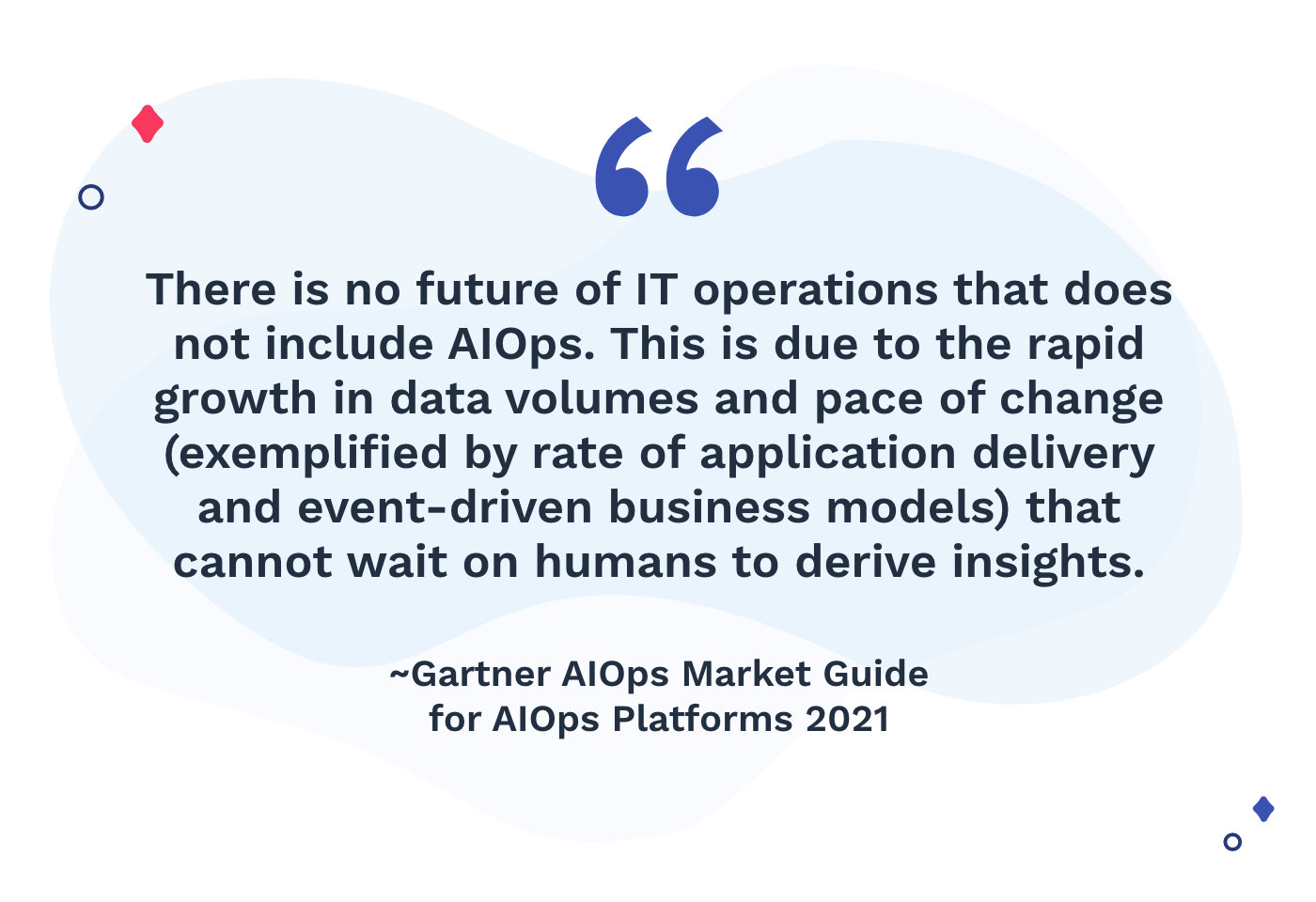
Equally important, now that remote work is the new normal, AIOps has emerged as a lifeline for Ops pros who now find themselves having to maintain the uptime and stability of critical digital services while teleworking.
By facilitating remote collaboration, streamlining incident management, and accelerating detection and resolution, AIOps has become the foundation for a collaborative operations environment.
What are the Key Capabilities of AIOps
The key capabilities and benefit of AIOps is that it gives DevOps, SRE and ITOps teams the speed and agility they need to detect incidents early in order to ensure the uptime of critical services and the delivery of an optimal digital customer experience. It’s been hard for these teams to accomplish this, due to brittle rules-based processes, the creation of silos due to specialization, and above all, too much repetitive manual activity.
Here are more details about the key capabilities of AIOps:
-
-
Noise Reduction: AIOps removes noise and distractions enabling busy engineers to focus on what’s important and not be distracted by irrelevant alerts. This speeds up the detection and resolution of service-impacting issues and prevents outages that hurt sales and the customer experience.
- Correlation: By correlating information across multiple data sources AIOps eliminates silos and provides a holistic, contextualized vision across the entire IT environment – infrastructure, network, applications, storage — on-premises and in the cloud.
-
Collaboration: By facilitating frictionless, cross-team collaboration between different specialists and service owners, AIOps accelerates diagnosis and resolution times, minimizing disruption to end-users.
-
Context: Advanced machine learning captures useful information in the background and makes it available in context to further improve the handling of future incidents.
-
Remediation: Through knowledge recycling and root cause identification, the workflows for solving recurring incidents can be automated, moving Ops teams closer towards a ticketless and self-healing environment.
-

Where Does AIOps Fit into the Modern IT Environment?
When looking at AIOps for the first time, it may not be obvious how it fits into the existing tool categories. This is because AIOps does not replace existing monitoring, log management, service desk, or orchestration tools. Instead, it sits at the intersection of these domains, integrating information across all of them and providing helpful output to ensure a synchronized picture is available.
These tools are valuable in their own right, but it’s hard to access the right piece of information at the right time. Hard-coded integration logic struggles to keep pace with the rate of change of modern IT environments. AIOps provides a much more flexible approach to assembling these different partial views into a single comprehensive understanding of what is vital for IT Ops teams to know.
As such, an AIOps platform plays the role of organizing and integrating what an organization’s domain-specific IT monitoring and management tools do, intelligently integrating the stack’s functionalities. The AIOps platform acts as the brain that brings together these tools and becomes a coordinating, central layer.
Domain-Agnostic vs Domain-Centric AIOps - What's the Difference?
There is a lot of confusion in the market about AIOps solutions. Many vendors claim to have AIOps solutions, but many times these solutions are adding AIOps capabilities like machine learning and algorithms to replace the rules and heuristics that powered their solutions. To understand the difference, Gartner divides AIOps solutions into two categories – Domain Agnostic and Domain Centric
Domain-Centric AIOps solutions are built for a limited number of use cases because they tend to focus on a single domain and do not ingest data from other sources. They rely on their own agents or collectors to get “first-party” data. Many monitoring and observability tools fall into this category. Some domain centric solutions have begun to ingest data from other sources, but they tend to be costly, so many orgs limit the third-party data being ingested.
Domain-Agnostic AIOps solutions work across domains to pull in data from multiple sources and IT technologies from multiple vendors. They take data from all your monitoring tools (logs, event data, metrics, traces) and normalize, enrich and correlate them to provide you with the ability to connect the dots and give you a more comprehensive view of all your systems.
So which is right for you?
If you have a diverse set of point monitoring tools and a wide variety of technology or know that you’ll be scaling in the future through cloud adoption (hybrid cloud, migration, etc.) then starting with a domain agnostic tool will set you up for now and the future.
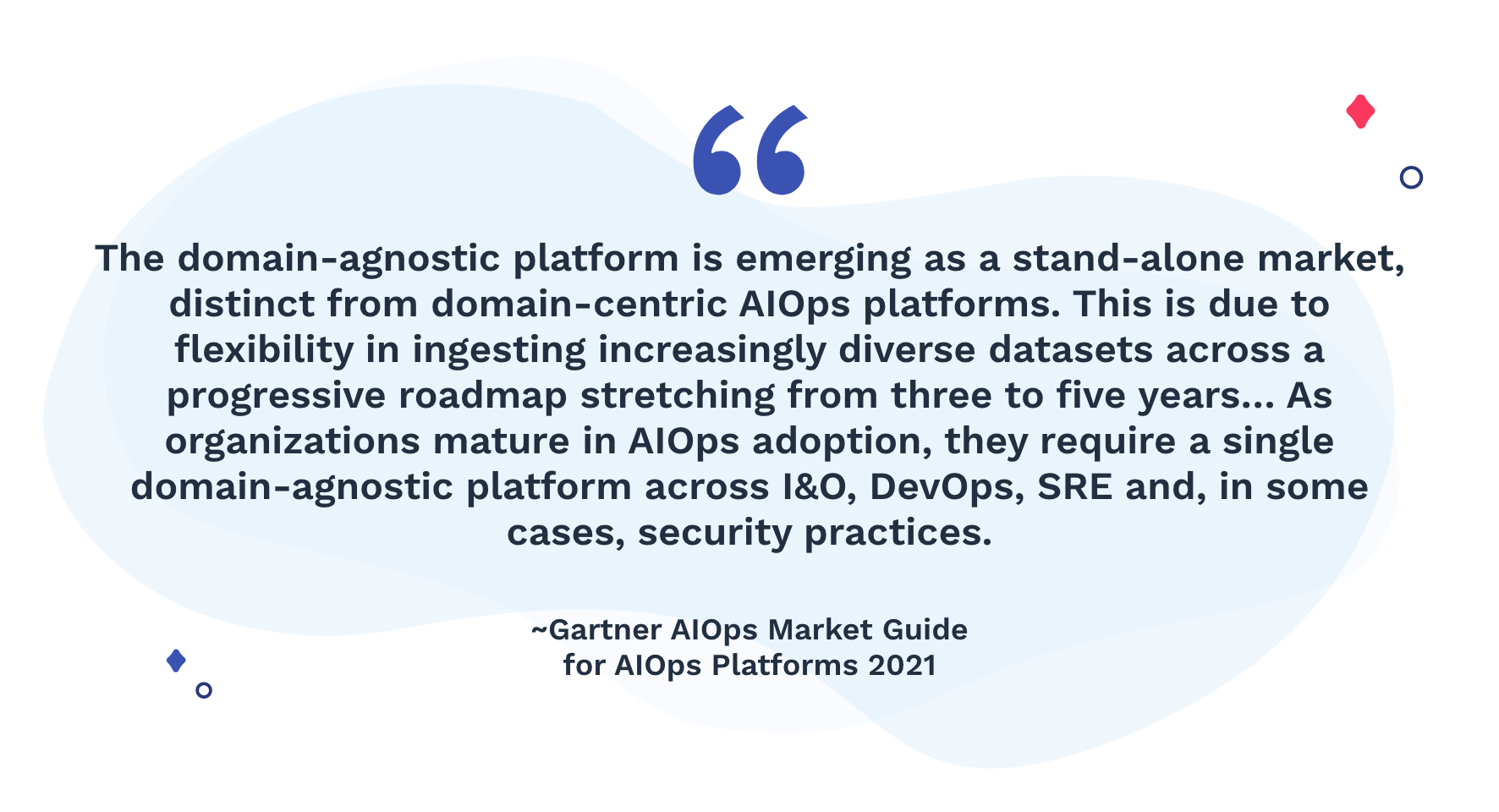
Who Is Using AIOps and for What?
AIOps is being used globally by organizations of all types, industries and sizes, and for a variety of scenarios.
Enterprises with Large, Complex Environments
AIOps adopters include companies with extensive IT environments and spanning multiple technology types, which are facing complexity and scale issues. When you have a business model heavily dependent on IT, AIOps can make a massive difference to the success of the company. Though these organizations may be in different industries, they share a common scale and accelerate change. The need for business agility creates more demand for IT agility.
Cloud-Native SMEs
AIOps is also being embraced by small and medium size enterprises (SMEs), particularly those born in the cloud, who need to develop and release software continuously and quickly. AIOps allows the SRE teams in these SMEs to continually sharpen their digital services while preventing glitches, malfunctions, and outages.
DevOps Teams in Organizations of All Sizes
Companies with a DevOps model can struggle to maintain alignment between the different roles involved. Direct integration of Dev and Ops systems into an overall AIOps model smooths away much of the potential friction. AIOps gives Dev teams a better understanding of the state of the environment and grants Ops teams complete visibility of when and how developers are making changes and deployments into production. This holistic view ensures that CI/CD cycles run uninterrupted and that apps are created and delivered quickly and seamlessly.
In addition, DevOps pipelines generate massive amounts of data. To maintain the stability and speed of application delivery, DevOps leaders must analyze it quickly and continuously. In addition, DevOps pipelines generate massive amounts of data. While DevOps teams have automated most of their functions, many still have a manual decision-making process, creating bottlenecks and ill-informed actions. AIOps, with its ability to analyze data and recommend actions, is the key to making precise data-driven decisions and automating activities for rapid application delivery.
As Gartner states in its “Augment Decision Making in DevOps Using AI Techniques” report: “AI-driven approaches leverage the continuous data streams to enable pattern recognition, anomaly detection, and prediction and causality.” Gartner forecasts that “by 2022, DevOps teams that leverage AIOps platforms to deploy, monitor and support applications will increase delivery cadence by 20%.”
Organizations with Hybrid Cloud and On-Prem Environments
Moving workloads to a public cloud platform has well-known benefits, but there are also good reasons to keep certain applications and infrastructure on-premises. For this reason, many organizations find themselves with hybrid environments, which brings its own set of IT operations challenges. By delivering a holistic, comprehensive view across all infrastructure types and helping operators understand relationships that change too quickly to be documented, AIOps helps Ops teams maintain control over these environments and provide service assurance.
Businesses Undergoing Digital Transformation
Digital transformation is the digitization of business processes to make the organization more efficient, agile, and competitive. At the heart of digital transformation initiatives is IT, which needs to operate at the speed that the business requires if it is not to become a bottleneck, preventing the achievement of the broader goals. By automating IT operations and preventing glitches that disrupt these digitized processes, AIOps helps IT deliver the level of technical support that successful digital transformation projects require.
Common Misconceptions about AIOps
AIOps has long had a reputation of being difficult to implement, requiring a long time to deliver value, and resource intensive. That isn’t necessarily true anymore. Let’s look at some common misconceptions.
Long Time To Value
Up until recently, AIOp solutions were mainly deployed on-premises in a local data center. With the move to software as a service (SaaS), the complexity of deploying and delivering value has been slashed significantly. Solutions that use Natural Language Processing (NLP) algorithms can deliver real business value in a matter of days vs the months and years of other solutions.
Complicated and Time-Consuming
SaaS offerings of AIOps have significantly reduced the steps needed to deploy and the resources needed to maintain. AIOps solutions that offer intuitive UIs self-service capabilities like creating your own integrations enables faster adoption and requires fewer resources to manage and maintain.
Expensive
There are many aspects that can contribute to the expense of any solution – licensing costs, hardware costs, staff to implement and maintain costs, etc.. Today’s AIOps solutions delivered via SaaS significantly reduce or eliminate many of the costs. Since it’s SaaS:
- You don’t need your own hardware to run it
- Implementation and on-going maintenance are very low
- It requires far fewer staff to manage
- You can start small and increase your usage incrementally based on business needs
Why do I need AIOps?
AIOps solutions provide greater visibility of IT environments that are becoming increasingly ephemeral, heterogeneous, distributed, and hybrid. They aggregate data from multiple tools and systems and stitch that data together to provide focus and context when problems occur. Some key business benefits include:
Improved Reliability and Availability
AIOps solutions reduce the amount of noise created and help DevOps, SRE, and IT Ops teams detect incidents earlier, allowing them to fix problems before they impact customers.
Reduced Operating Costs
While there are a number of ways AIOps solutions reduce cost, a key one that is particularly challenging is increasing headcount. Manual incident management is slow and time-consuming.
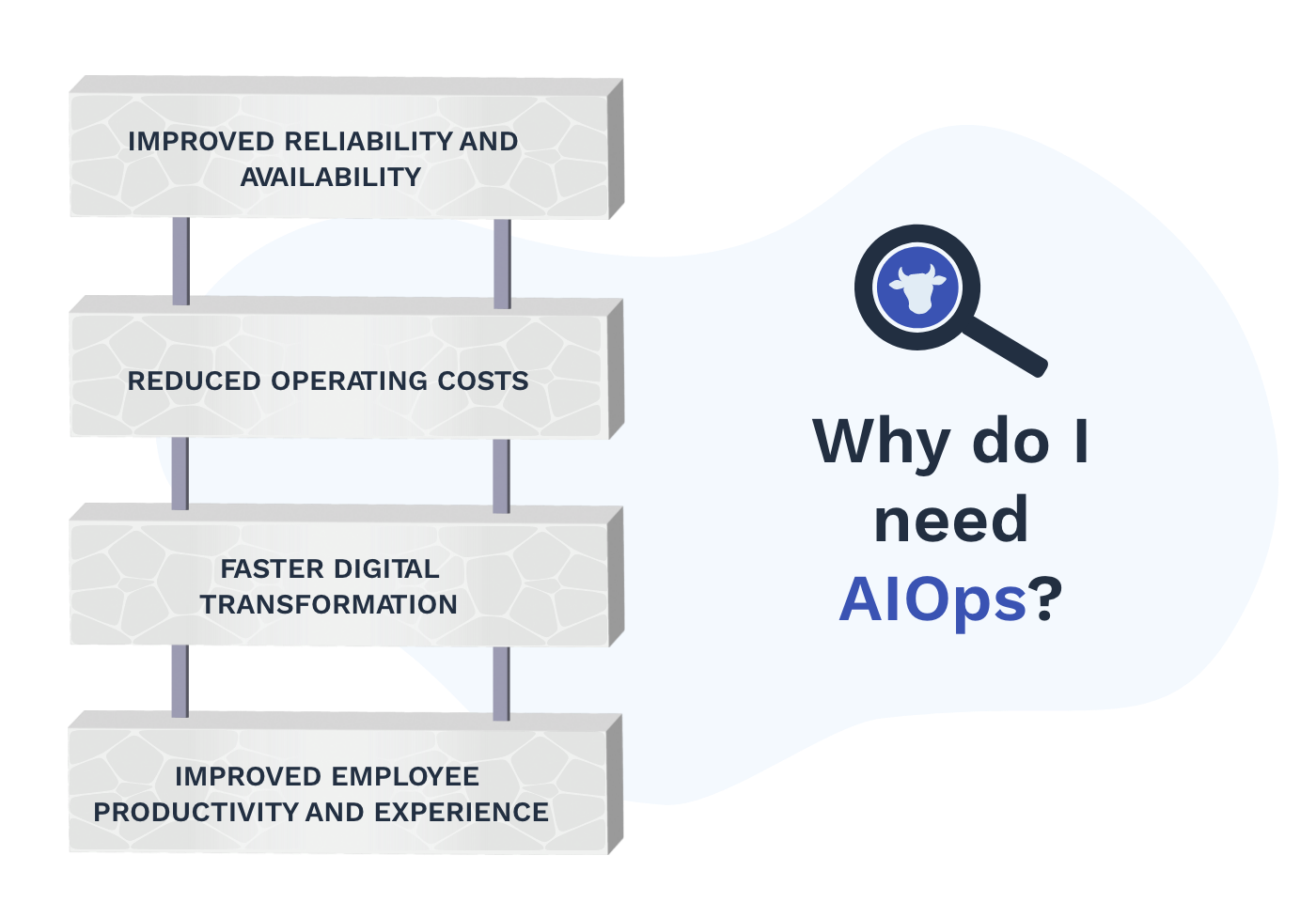
As complexity and data volumes increase, organizations try to solve the problem by increasing headcount. AIOps significantly reduce the number of alert, provide actionable insights about incidents, and automate workflows. This allows organizations to improve efficiency to keep headcount flat, reduce the number of escalations, and reduce downtime.
Faster Digital Transformation
AIOps solutions helps DevOps and SRE teams quickly identify problems to keep cloud adoption and migration projects on track. Less time troubleshooting means more time innovating. Additionally, AIOps can help act as a bridge during cloud adoption / migration periods as the central point for all monitoring and observability data – allowing downstream teams to continue with their existing on-call tools without additional configuration needs.
Improved Employee Productivity and Experience
Pager fatigue and constant firefighting wears on employees. It takes their focus away from what helps drive the business and puts them in extended periods of stress. AIOps automates many of the time consuming tasks and repetitive tasks and allows them to focus on what is important and interesting, increasing employee satisfaction.
The Economic Value of AIOps
When evaluating the financial benefits of an AIOps platform, it’s essential to look beyond its ability to reduce costs. Don’t ignore the benefits side of the equation — both direct benefits and the technology’s future impact on enhancing flexibility and reducing risk.
AIOps’ value can often be justified based on the achieved business benefits. For example, AIOps helps prevent disruptions of critical digital services and accelerates detection and resolution. In that way, AIOps optimizes revenue generation because when apps malfunction, sales are lost.
It also plays a direct part in customer satisfaction, retention, and brand reputation protection, all of which are directly related to business performance and profitability.
Let’s look at a real-world example.
A large financial services institution cut its MTTR by a whopping 85%. It slashed its Level 1/2 tickets by 75%, its Level 3 tickets by 15%, and its Level 4 tickets by 50%. The financial benefits to the business beyond simple cost reduction: Tens of millions of dollars.
These results happened because of a multi-pronged strategy encompassing several key use cases, including:
- Dramatically improving in the clustering of alerts around incidents. The company went from a limited, inefficient process to an AIOps-driven ingestion and correlation process that consolidated alerts into contextually-rich incidents, leading to a massive reduction in tickets created.
- Integration with the ITSM / CMDB system. This drastically simplified and accelerated ticketing, leading to faster, more effective routing, prioritizing, handling and resolution of incidents.
- Automated knowledge capture and recycling. With the knowledge capture and recycling process totally automated, operators are notified of resolved past incidents that are similar to current ones, and provided all resolution documentation, accelerating MTTR.
AIOps Market Momentum
The adoption of AIOps is growing strongly worldwide, as global enterprises use it successfully to attain continuous availability. Here’s a sampling of research findings describing the momentum of AIOps.
- Global Market Research predicts Artificial Intelligence for IT operations (AIOps) Market size exceeded USD 2 billion in 2020 and is expected to register gains at over 20% from 2021 to 2027 to reach USD 10 Billion.
- According to research from Digital Enterprise Journal, there has been an 83% increase in the number of organizations deploying or looking to deploy AIOps capabilities since 2018.
- MarketsandMarkets estimates the global AIOps platform market size to grow from $2.55 billion in 2018 to $11.02 billion by 2023, at a Compound Annual Growth Rate (CAGR) of 34.0% during the forecast period.
- Almost half of all DevOps pros who responded to a 451 Research survey done in 2020 said they currently use AIOps.
- Companies surveyed by Enterprise Management Associates ranked AIOps as the most successful IT analytics investment, with 81% indicating that the value they get from AIOps exceeds its cost, including 42% who said it does so “dramatically.”
- Enterprise Management Associates also found that AIOps is the IT analytics option that larger enterprises prefer and supports a broader range of use cases. It ranked at the top for having broader support for third-party toolset integrations and stronger support for integrated automation, including AI bots.
- In its “2019 Strategic Roadmap for IT Operations Monitoring,” Gartner includes this recommendation for leaders focused on infrastructure, operations and cloud management: “Augment root cause analysis and IT Ops staff performance by using AIOps platforms to uncover insights from broad IT Ops datasets.”
- In its “Market Guide for AIOps Platforms,” Gartner forecasts that “by 2023, 40% of DevOps teams will augment application and infrastructure monitoring tools with AIOps platform capabilities” and also states that:
- “There is no future of IT operations that does not include AIOps.”
- “AIOps platforms enhance I&O leaders’ decision making by contextualizing large volumes of varied and volatile data. I&O leaders should use AIOps platforms for refining performance analysis across the application life cycle, as well as for augmenting IT service management and automation.”
- “Enterprises that adopt AIOps platforms use them as a force multiplier for monitoring tools correlating across application performance monitoring (APM), IT infrastructure monitoring (ITIM), network performance monitoring and diagnostics tools, and digital experience monitoring.”


